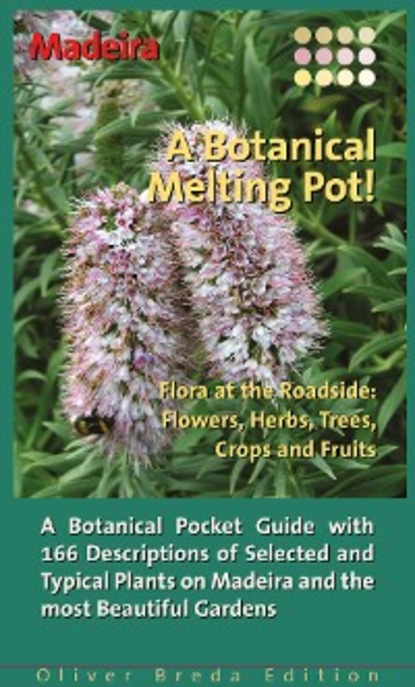
Полная версия:
Madeira
Site:
For aesthetic purposes, canalized riverbeds in Funchal and Santa Cruz are covered with wires on which are growing Bougainvillea plants. They also grow on other sites and are among the most popular ornamental plants on Madei-ra for their abundance of flowers. Up to an altitude of 450 m (490 yd.) and especially in the south you can find them nearly everywhere.
Interesting to know:
Although to a smaller extent, the similar Great Bougainvillea (Bougainvillea spectabilis) is also cultivated on Madeira. It has hairy leaves and purple-red, heart-shaped petals. Crossbreeding of the two species allowed to develop specimens of various colours (purple, pink, orange, white). The botanical denomination reminds of the French navigator Louis Antoine de Bougainville. The Bougainvilleas were discovered on an ex-cursion to Brazil 1766-1769 that was led by him.
42



In the Gardens
Gold Cup, Chalice Vine
Solandra maxima
Bloom time
All year round, except sum-mer.
Characteristics
The woody climber plant reaches up to 12 m (13 yd.) tall. The leathery leaves are elliptical and short-ta-pered. A very conspicuous feature are the yellow, fun-nel-shaped flowers. The calyx is curved outwards to form a broad, five-lobed hem. A purple-brown ridge runs into the centre of the funnel.
Site:
As it grows very tall in a short time, the plant is mostly cultivated in larger gardens and parks. On Madeira you will often see it in the south, up to an altitude of 350 m (385 yd.). There are for example several specimens to be found in Funchal in the park of the Quinta Vigia (198) or in the Botanical Garden (190).
Interesting to know:
The Gold Cup is native to the American tropics. The still closed buds contain water that is used there by traditional medicine to treat conjunc-tivitis. However, the plant itself is poisonous. The Indians used it for the production of intox-icating drugs. In nature, Gold Cup is pollinated by bats. Thus the blossoms open in the evening - and that fast that you can watch them de-veloping. Another typical characteristic for flowers that attract bats is the mawkish scent that is much more intense during night hours.
43
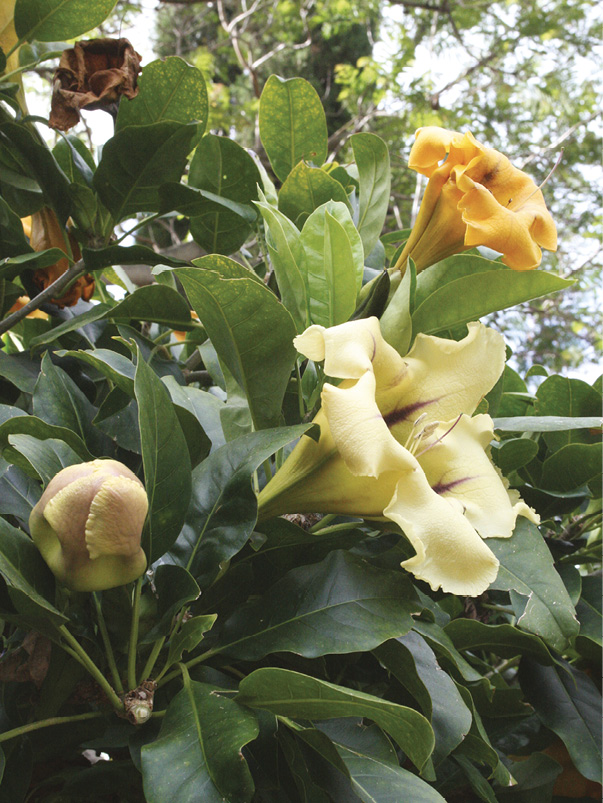
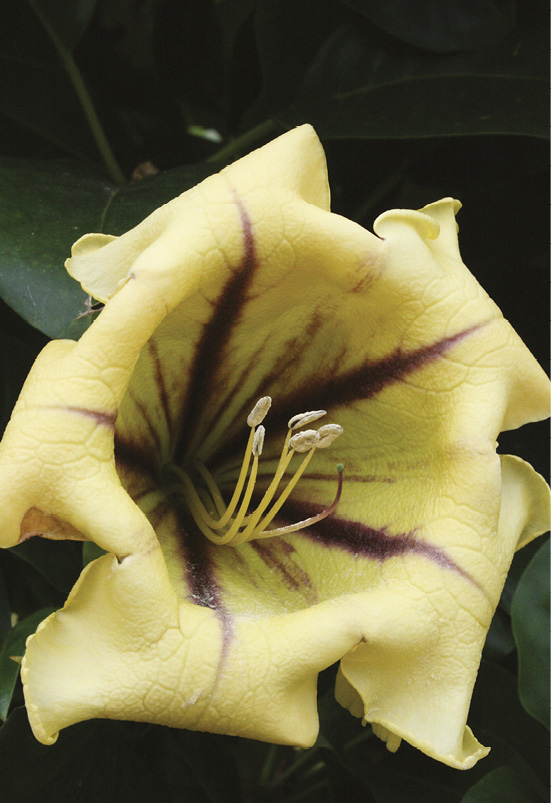


In the Gardens
Golden Shower,
Orange Trumpet Vine
Pyrostegia venusta
Bloom Time
From November to February.
Characteristics
This climber develops up to 10 m (11 yd.) long shoots. The leaves are mostly organized threefold; they are elliptic to longish with a lopsided basis. At the bottom, the leaves are covered with red-brown hairs. The shining blossoms hang down in dense panicles that reach up to 6 cm (2,5‘‘) long and resemble tubes or funnels.
Site:
On Madeira, the Golden Shower is most likely to be cultivated on walls, fences and pergolas. It grows mainly in the south of the island, up to an altitude of about 350 m (385 yd.). You will often find it both in private gardens and in pub-lic parks (e.g. Botanical Garden, Funchal, 190).
Interesting to know:
The Golden Shower is native to Brazil. Now-adays it is cultivated globally in tropical and subtropical countries. Golden Shower is part of the Bignonia family (Bignoniaceae). The Cape Honeysuckle (Tecomaria capensis), plant native to South Africa, which blossoms all year round, is as well assigned to this group. You can also find this poorly climbing shrub being cultivated on Madeira, often next to the Golden Show-er. Its leaves are organized in groups of 6-9; its blossoms are also forming dense panicles. They grow upright and open to showy funnels.
44
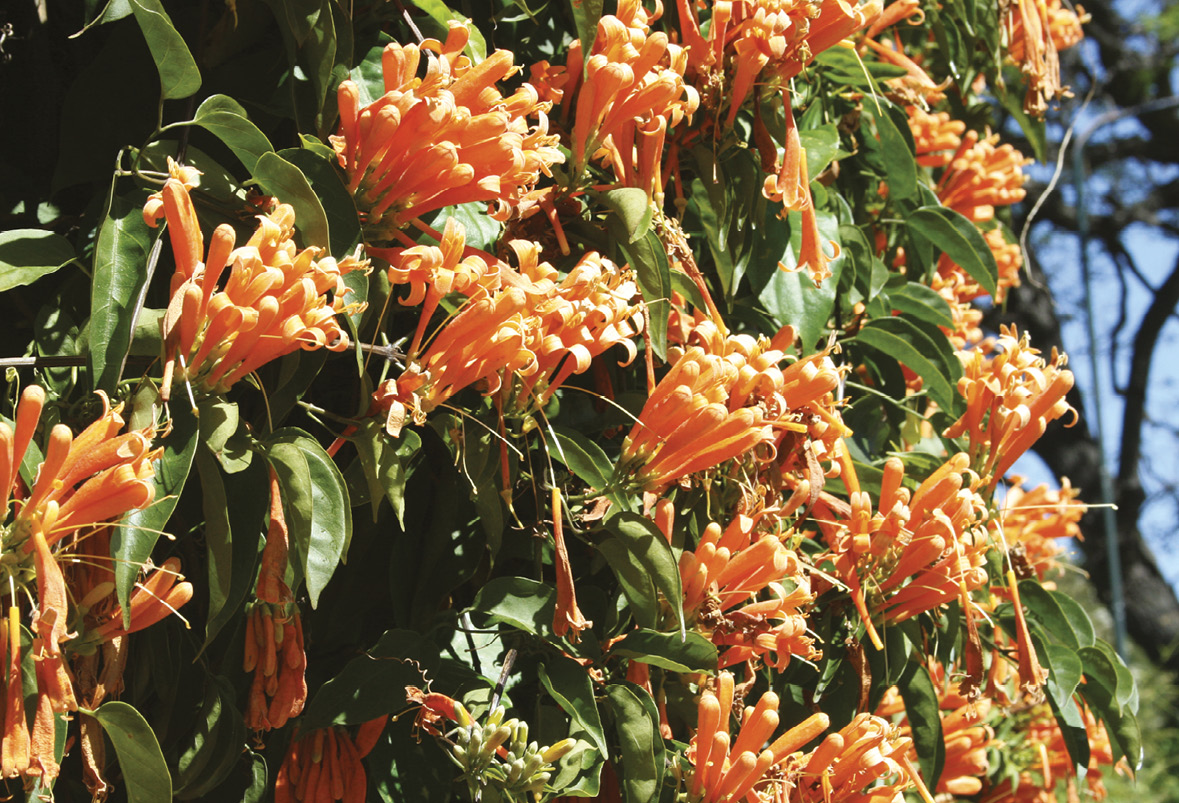


In the Gardens
Mexican Bread fruit
Monstera deliciosa
Bloom time
From June to September.
Characteristics
Branches of this climber can be more than 10 m (11 yd.) tall and develop numerous aerial roots. The giant leaves are firstly heart-shaped, later they become perforated with holes or pinnately lobed. The cream-coloured spadix is up to 25 cm (10‘‘) long and half cov-ered with a thick, white bract.
Site:
In the south of Madeira you will frequently see the Mexican Bread Fruit in various parks and private gardens up to an altitude of 400 m (440 yd.). You can for example encounter it in the Jardim Municipal (198) and in the Botanical Garden (190) in Funchal. It does not only climb along trees but also along walls and fences.
Interesting to know:
The plant is native to Mexico. In summer, the plant develops an edible spadix out of each in-florescence. In Portugal, this fruit is called “fruto delicioso” (delicious fruit) and valued as a deli-cacy. The spadix consists of numerous fleshy, hexagonal cells that mature little by little from the bottom to the top. The taste ranges be-tween a banana and a pineapple. Nevertheless you have to take care: the fruit contains oxalic acid that might cause irritations of the mucous membrances. On the market in Funchal the fruits are offered to the tourist for tidy prices.
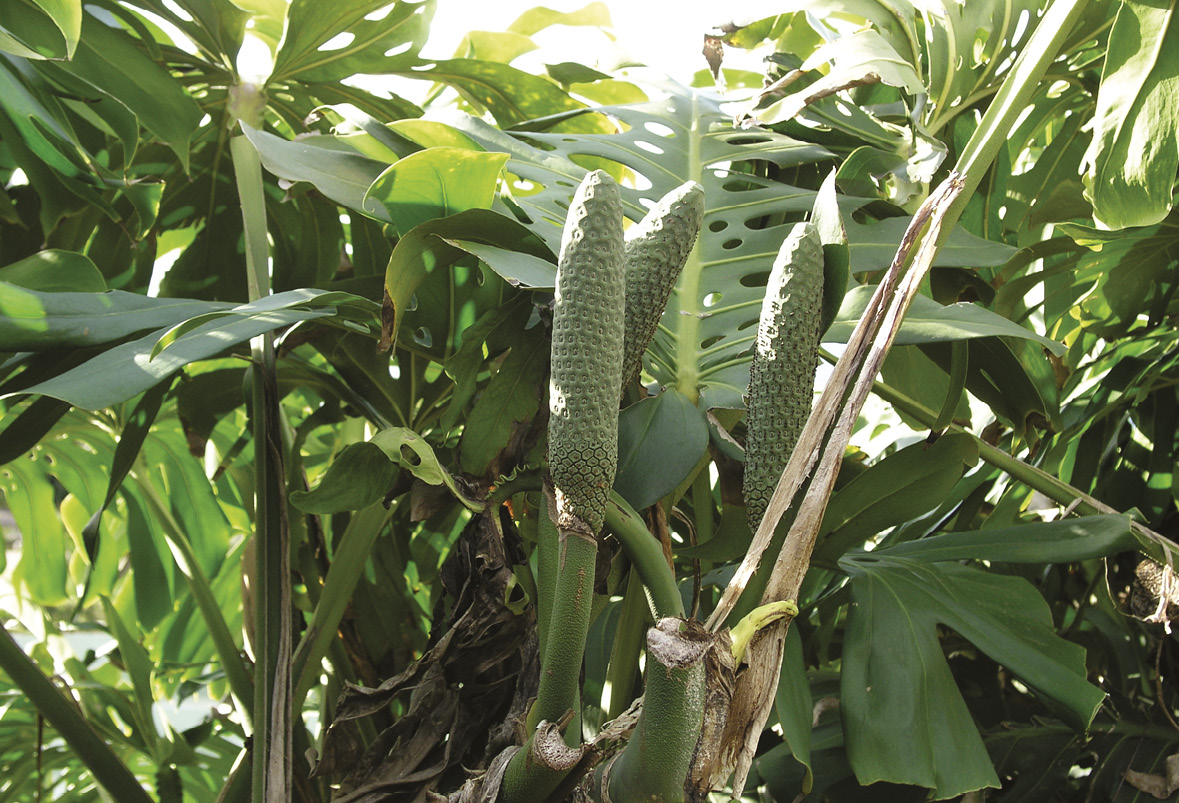
45


In the Gardens
Fan Aloe
Aloe plicatilis
Bloom time
April and May.
Characteristics
The plant only grows up to 2 m (6,6‘) tall but develops a thick trunk from which emerge numerous branch-es with a crest of long, fleshy, grey-green leaves at the end of each. The leaves are organized in two oppo-site files. The red racemes resemble pointed cones and grow upright on thin stalks.
Site:
The Fan Aloe origins from South Africa. In the south of Madeira it is cultivated up to an altitude of 400 m (440 yd.) and decorates both private gar-dens and parks. Some especially beautiful spec-imens are growing in the succulent plants sec-tion in the Botanical Garden (190) of Funchal.
Interesting to know:
The Fan Aloe was already introduced to Europe in the 17th century and since then has been very popular as a container plant. Outdoors it only flourishes all year round in habitats without any frost. Together with Barbados Aloe (85), the Fan Aloe counts among the species from which aloe resin is extracted. The resin is produced by squeezing the sap from the leaves and thickening it. Mixed with sulphuric acid the aloe resin can be employed as dye. Occasionally it is still used as a laxative. For this effect it was indispensable in former times when defeca-tion was the basis of every medical treatment.
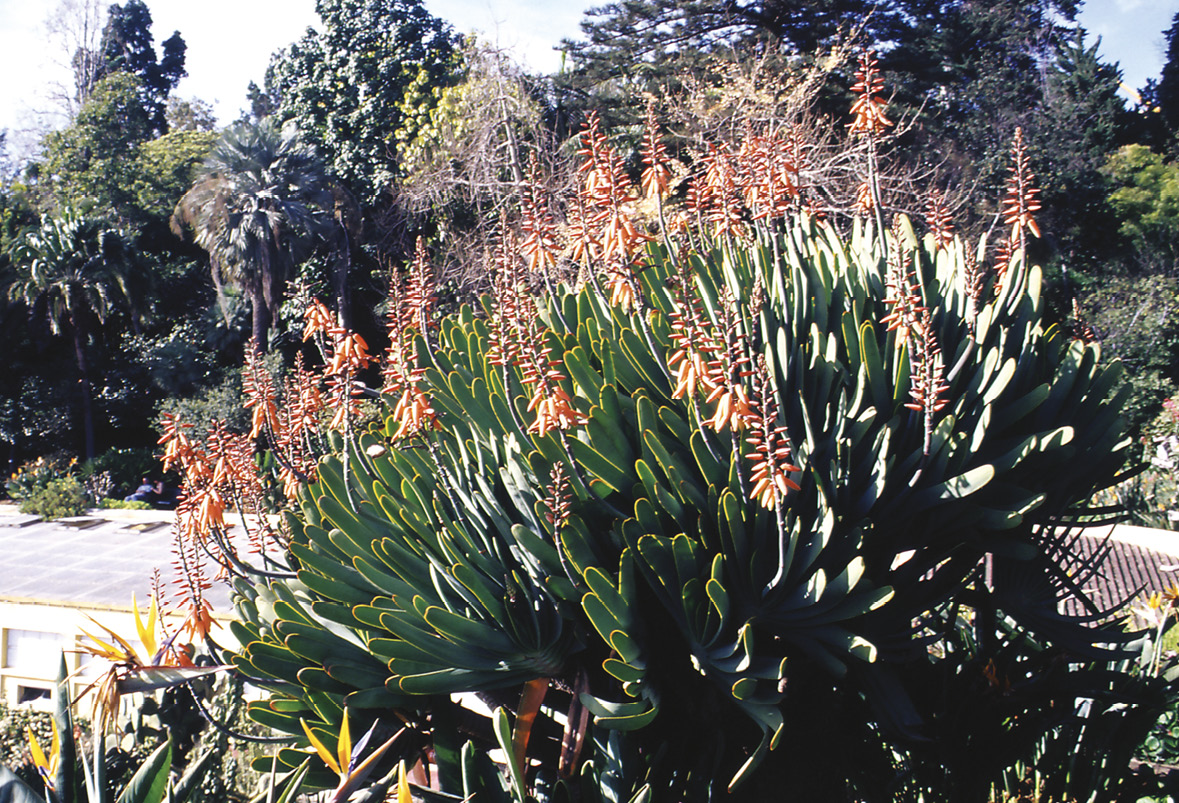
46


In the Gardens
Sword Aloe
Aloe arborescens
Bloom time
From October to February.
Characteristics
The slender, fleshy leaves have serrated margins. They are organized in dense rosettes with a diameter of about 50 cm (20‘‘). Several rosettes are situated on each of the short, branched trunks. Long stalks with various cone-shaped, shining red flowers emerge out of every rosette.
Site:
In the southern coastal regions the Sword Aloe is one of the most popular ornamen-tal plants lining the roadsides (up to an alti-tude of 600 m (656 yd.), although mostly on a lower level). It is often cultivated in gar-dens, parks and around special points of view. Sometimes it becomes wild in fallow land.
Interesting to know:
The Sword Aloe is native to South Africa. The remaining 200 Aloe species are also originating from Africa, Madagascar and Arabia. Although on the first sight you may observe a striking sim-ilarity with Agaves, the two genera are only dis-tant relatives. The latter’s habitat is restricted on the regions between the south of the U. S. A. and South America. Anyway, both genera were lead independently to similar adaptations and to a similar outer appearance by comparable living conditions in interim habitats between savannah and desert (thorn bush savannah).
47
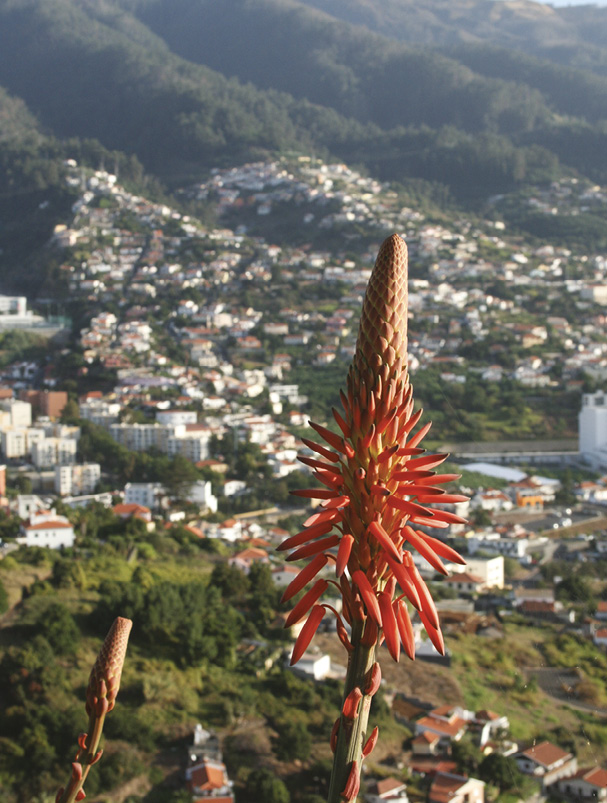



In the Gardens
Bear’s Breech
Acanthus mollis
Bloom time
From May to July.
Characteristics
The herbal plant develops candle-shaped inflorescences that grow up to 1 m (3,3‘) tall. The tongue-shaped single blooms are whitish with pur-ple veins. The superior lobe of the calyx is remarkably enlarged. The large, dark green leaves are strongly lobed and have substantial leaf veins.
Site:
You will mostly find Bear’s Breech in gardens in the south of the island, up to an altitude of 600 m (655 yd.). It often grows wild along streets or levadas. You can see numerous specimens in the Palheiro Gardens at the entrance to the Camellia Avenue. You will also encounter it in Camacha.
Interesting to know:
The Bear’s Breech is native to the Mediterra-nean region and Asia Minor. As those of the Spiny Bear’s Breech (Acanthus spinosus), its leaves served as models for the ornaments at the pillar capitals of the Corinthian temple in ancient Greek. Later this symbol of fertil-ity was taken over by the Romans. Since the 15th century it has been picked up again and again in European architecture. On Madei-ra you may often find it in form of ceramic sculptures on the corners of old houses’ tiled roofs. They symbolize the large number of chil-dren that shall be bestowed upon the family.

48


In the Gardens
Rosea Ice Plant
Drosanthemum floribundum
Bloom time
From April to July.
Characteristics
Конец ознакомительного фрагмента.
Текст предоставлен ООО «ЛитРес».
Прочитайте эту книгу целиком, купив полную легальную версию на ЛитРес.
Безопасно оплатить книгу можно банковской картой Visa, MasterCard, Maestro, со счета мобильного телефона, с платежного терминала, в салоне МТС или Связной, через PayPal, WebMoney, Яндекс.Деньги, QIWI Кошелек, бонусными картами или другим удобным Вам способом.
Вы ознакомились с фрагментом книги.
Для бесплатного чтения открыта только часть текста.
Приобретайте полный текст книги у нашего партнера:
Полная версия книги
Всего 10 форматов



